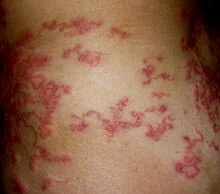Serpiginous
Serpiginous, first known to be used in the 15th century, is a term from Latin serpere (“to creep”), usually referring to a creeping, snakelike or slowly progressive skin disease.
[1][2] It is used to describe the rash in cutaneous larvae migrans,[3] erythema annulare centrifugum,[4] cutaneous pili migrans,[5] purpura annularis telangiectoides, ringworm,[6] balanitis circinata,[7] and some cases of bullous pemphigoid.
[8] It is also used to describe serpiginous choroiditis, a rare eye condition in which irregularly shaped (serpiginous) lesions are seen in two layers of the eye surface (the choriocapillaris and the retinal pigment epithelium).
[9] This dermatology article is a stub.
You can help Wikipedia by expanding it.
